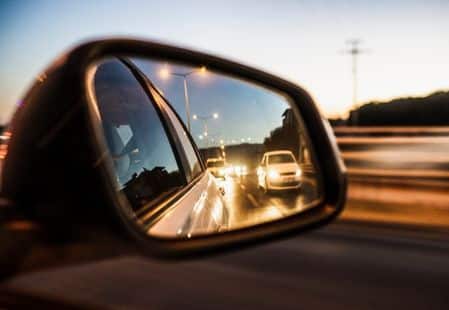All drivers have a responsibility to do what’s possible to prevent injuring other people. Since it’s not possible to see someone in your blind spot (it’s called a “blind” spot for a reason), many drivers think they cannot be held responsible for crashes caused when others are in their blind spots.
How does this argument hold up in court? Not well.
How Do Blind Spot Crashes Happen?
Blind spot crashes typically occur when someone changes lanes or merges into another vehicle. Blind spot crashes are a big problem around these parts, as Columbus and Phenix City have many blind curves that suddenly drop from two lanes to one lane, and that can cause problems for drivers who aren’t expecting it and can’t see the lane reduction until it is already upon them.
Blind spot crashes can also occur when drivers are forced to swerve or change lanes to avoid a stalled vehicle or a prior crash. It is especially common for one wreck on roads that experience heavy traffic like 2nd Avenue, Victory Drive, Buena Vista Road, or Cusseta Road to end up causing more wrecks.
Where Are the Blind Spots on My Vehicle?
The two major blind spots on any vehicle are:
- Directly behind your vehicle
- The area on the right side of your car behind the passenger side window where the view is blocked by the front passenger seat
However, depending on the vehicle you drive, there may be others, including over the driver’s left-hand shoulder. As a rule, larger vehicles tend to have larger blind spots.
Motorcyclists, cyclists, and pedestrians are more likely to be hidden from view in blind spots than large vehicles like SUVs and pickups.
You Are Still Liable for Blind Spot Crashes
When traffic coming from Atlanta and Ft Benning (formerly Ft Moore) merges with traffic on our local roads and highways, it means more drivers jockeying for the same amount of road. That means there is less space between vehicles, and more vehicles inside each other’s blind spots all trying to get where they are going as fast as they can.
While you might assume other drivers have a responsibility to make room for you to merge before you run out of lane, and that they can be held liable for collisions when they don’t, this is not the case. Merging drivers do not have the right of way and should only merge when it is safe to do so.
When you are attempting to change lanes, you should be aware of where the blind spots on your vehicle are, and that there is a possibility of a vehicle being in your blind spot. That means you should always be checking your blind spots before backing up, turning, merging, or changing lanes.
However, the driver in the blind spot may share liability in some specific instances. For example, they can potentially be held liable if they were passing on the right illegally, or if they sped up to prevent another driver from legally passing them on the left.
If two drivers are changing into the same lane at the same time, determining who is at fault gets a little more complicated, although it usually depends on which driver had the right of way and which began changing lanes first. You will want to hire an experienced lawyer to help sort out liability.
How to Check a Blind Spot
Blind spots are areas around your vehicle that are often unseen even with your vehicle’s mirrors. So how can you check them?
The simplest way is to physically look over your shoulder through the rear passenger side window. It is important to take quick looks and hold the steering wheel steady, so you are not facing away from the road for too long. You can also install blind spot mirrors, which are small, usually round, convex mirrors that you can stick into the corner of your sideview mirrors to allow a wider view behind you.
You should also always use your turn signal, and signal plenty of time before actually changing lanes, rather than immediately changing lanes as soon as you signal. Wait at least one full “Mississippi second” before changing lanes after signaling, at minimum.
A better rule of thumb is to wait three to five seconds. This gives drivers who may be in your blind spot enough time to realize your intentions and either move out of your blind spot or alert you that they are there.
Many newer cars also come with blind spot monitors, which use sensors to detect when another vehicle is in your blind spot. They will beep and flash a warning if a car is in your blind spot when you turn on your turn signal.
After a Blind Spot Accident, Get Gary Bruce
Blind spot accidents are often contentious and hard to prove. In states like Alabama, where even 1% of blame being cast on you can prevent you from getting any compensation at all, even with grievous injuries, it’s vital to get an experienced car wreck lawyer on your side who can prove you weren’t at fault for your wreck.
Contact us today to learn how we can help you in a free consultation.
